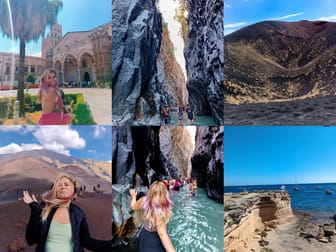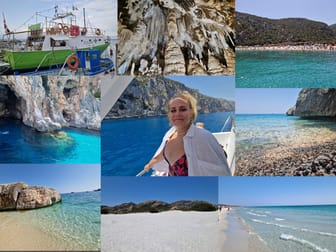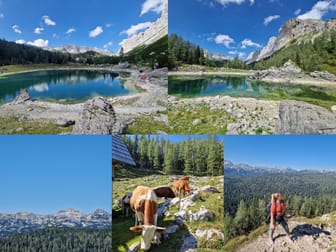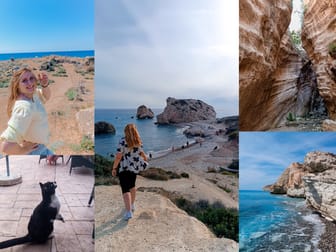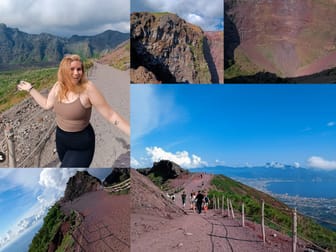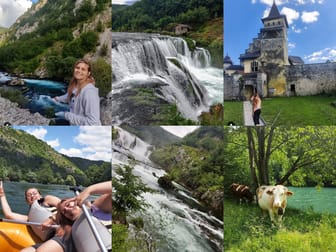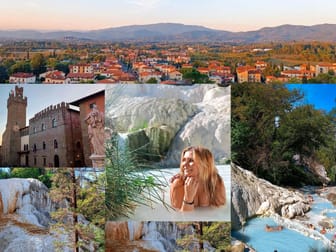6 Unique Destinations That Blend Culture and Geology: A Travel Guide
Discover six extraordinary destinations where culture and natural beauty collide. From ancient landmarks to breathtaking landscapes, these travel spots offer unforgettable experiences.
Petra Hus
Jan 07 2025
Hey everyone! I'm Petra, a biologist and geologist from Croatia with a passion for travel. Let me share my top unique destinations that blend amazing cultural sites with fascinating geological features.

1. Alcantara River, Sicily, Italy
So far, the most breathtaking place I’ve ever visited has to be the Alcantara Gorges, and it’s for two fascinating reasons: the mythical legend behind its origin and the incredible natural science that explains it.
Sicily is steeped in folklore, and one legend tells the story of how the Alcantara River was born. Venus, the goddess of love, fell for the rugged charm of Mars, betraying her husband, Vulcan, the fiery god of the forge. Enraged by her infidelity, Vulcan unleashed his wrath
through Mount Etna, causing rivers of lava to flow and carve deep gorges into the land. The tale takes a bittersweet turn when Venus, overcome with guilt, wept tears of remorse. Her magical tears cooled the molten rock, creating the river and its crystal-clear waters—a lasting symbol of sorrow and love’s consequences.
But what does science say? The gorges were formed around 8,000 years ago during a prehistoric eruption of Mount Etna. Lava, rich in magnesium and iron, flowed into the valley and cooled rapidly, forming basalt—a volcanic rock that cracked into striking hexagonal
columns through a process called columnar jointing. Over millennia, the Alcantara River eroded the basalt, sculpting the dramatic canyon seen today.
The gorges are not just a geological wonder but also a thriving ecosystem. The riverbanks are adorned with olive trees, citrus groves, and vibrant wildflowers like violets and poppies. Birds such as kingfishers and herons flit above the water, while trout and eels swim below. The surrounding woodlands are home to foxes, wild boar, and even otters.
For more details on how to get there and tips and tricks how to skip tourist traps, visit my Thatch blog:

2. Grotta di Santa Barbara, Sardinia, Italy
Second place definitely goes to Grotta di Santa Barbara. For our anniversary, my boyfriend and I always embark on an exciting adventure, and in 2024, that adventure led us to
Sardinia! While we adore the beaches and the sea, the soaring temperatures and intense sun eventually became too much, and we needed a cool escape. That’s when we decided to explore Sardinia’s caves. One of the most impressive caves I’ve ever seen as a geologist is Grotta di Santa Barbara.
This remarkable cave, a hidden gem in the Iglesiente region, was discovered in 1952 during excavation work for a tunnel. Workers unearthed a stunning cavern filled with dark brown, tabular barite crystals nestled between limestone and silicified dolomite, dating back around 500 million years. The cave is accessible through a network of underground tunnels, offering a truly breathtaking experience. Visitors first travel by train for 700 meters, followed by an
elevator that ascends into an underground cathedral adorned with vibrant rock formations.
Located in the Supramonte mountain range, Grotta di Santa Barbara is a striking karst cave known for its exceptional geological features. Over millions of years, water has eroded the Mesozoic limestone, creating stalactites, stalagmites, and other intricate speleothems.
The cave also contains beautiful barite and aragonite crystals. Barite, formed through the precipitation of barium sulfate from mineral-rich groundwater, appears as white, translucent clusters. Aragonite crystals, a polymorph of calcium carbonate, thrive in the humid cave
environment, growing due to the combination of temperature and mineral-rich water. The temperature inside remains constant year-round, with high humidity promoting the growth of these minerals.
To visit, booking in advance is essential, especially during the peak tourist season in August.
For more information, check out my Thatch blog:

3. Mount Etna, Sicily, Italy
Third place goes to another natural gem, Mount Etna. This was also part of our Sicily adventure, which included the previously mentioned Alcantara River. Etna is simply out of this world. When you arrive, it feels as though you’ve stepped onto another planet. The landscape transforms from lush greenery to a stark black surface dominated by magmatic rocks from past eruptions, along with numerous craters at varying heights.
Mount Etna, Europe’s tallest active volcano, formed around 500,000 years ago as a result of tectonic activity at the boundary between the African and Eurasian plates. This subduction zone allowed magma to rise through fractures in the Earth’s crust, creating Etna’s volcanic
structure. Initially, submarine eruptions formed the base, which gradually emerged above sea level through subsequent eruptions. Etna’s geology is complex, with layers of basaltic lava, pyroclastic deposits, and volcanic ash from countless eruptions. Its mafic lava, rich in magnesium and iron, is highly fluid, allowing for widespread flows. Over time, these eruptions shaped Etna’s massive cone and contributed to the fertile landscape surrounding it.
One of the most fascinating aspects of Etna is its abundance of ladybugs. These vibrant insects are attracted to the volcanic soil, which is rich in minerals and nutrients. The mineral- rich environment, especially after an eruption, provides an ideal habitat for the aphids that ladybugs feed on, creating a thriving population. The sight of ladybugs dotting the volcanic landscape adds a splash of colour to the otherwise stark terrain.
While it’s possible to reach Etna by public transport, I would highly recommend a guided tour. Public buses have limited space, and tours are relatively affordable. Most offer pick-up from your accommodation, and the guides are incredibly knowledgeable about the volcano’s history and activity.
More info here:

4. Seven Lakes Valley, Triglav National Park, Slovenia
Ohhhh, this summer, I hiked one of the most breathtaking trails I've ever experienced—truly a vacation for the soul. From the vibrant violet flowers and changing vegetation to the emerald lakes nestled among karstic Alpine mountains, the Seven Lakes Valley in Slovenia is a sight to behold. Located in Triglav National Park, this popular hiking route is both challenging and rewarding. If you're in moderate condition, the pain is worth the gain!
The Julian Alps, stretching across northeastern Italy and western Slovenia, offer a fascinating look into the Earth's geological history. This mountain range, part of the Southern Alps, formed around 65 million years ago during the Alpine orogeny, when the African plate collided with the Eurasian plate. The resulting tectonic activity caused massive compression, uplifting the mountain range and forming complex rock structures. Primarily composed of limestone, formed from marine organisms, the Julian Alps have experienced significant tectonic forces, causing the rocks to fold, fracture, and uplift. The region also contains layers of dolomite, a magnesium-rich carbonate rock, contributing to the dramatic cliffs and peaks.
The Seven Lakes Valley, a striking glacial valley, was sculpted by glaciers around 10,000 to 12,000 years ago. These glaciers deepened the valley floor, creating the series of seven pristine lakes fed by mountain streams. The valley's characteristic U-shape is a direct result of glacial erosion, with surrounding limestone and dolomite cliffs providing a stunning backdrop.
In addition to its geological wonders, the Seven Lakes Valley is home to endemic flora and fauna adapted to the high-altitude environment. Unique plants like the Slovenian primrose (Primula auricula) and the iconic edelweiss (Leontopodium alpinum) thrive here. Wildlife includes the common chamois (Rupicapra rupicapra), the elusive Alpine ibex (Capra ibex), and the soaring golden eagle (Aquila chrysaetos), all adding to the valley's rich biodiversity. This breathtaking location offers a glimpse into the interplay between geological forces and thriving ecosystems, making it a truly unique natural sanctuary.
Complete detailed guide on how to get there, check out on the link:

5. Avakas Gorge, Cyprus
By now, I hope you know that I like gorges, so the next one, also unique, is Avakas Gorge. It is situated near Paphos and, unfortunately, only accessible by car. The thing that attracted me to it is the colours! Just imagine this: you are surrounded by beige and orange rocks,
with walls rising up to 30 meters, and beneath your feet, the cold Avakas River flows as you try to hop from one rock to another. This is a true adventure.
Avakas Gorge, located in the Akamas Peninsula of Cyprus, is a striking example of geological beauty shaped by millions of years of natural forces. This narrow, winding gorge is carved through limestone, a sedimentary rock formed from ancient marine organisms. The gorge's steep cliffs rise up to 30 meters in places, showcasing impressive layers of limestone and sandstone, which were laid down during the Mesozoic era, around 140 to 65 million years ago, a time when dinosaurs roamed the Earth. The gorge’s current form is a result of significant erosional processes, primarily caused by the flow of the Avakas River, which carved deep into the soft limestone over thousands of years. The river’s action, combined with rainwater infiltration and the dissolution of soluble rock, has created the dramatic, narrow passages and smooth, rounded rock formations that define the gorge today.
Avakas Gorge is not only a geological wonder but also a rich biological hotspot. The diverse ecosystem in and around the gorge supports a variety of plant and animal species, many of which are adapted to the dry, rocky conditions of the region. The gorge is home to several endemic and rare plant species, including the Cyprus tulip (Tulipa cypria), a beautiful flower that blooms in the spring, and the Cyprus rockrose (Cistus cyprius), which thrives in the rocky, sun-baked environment. The surrounding vegetation is dominated by Mediterranean shrubs, including aromatic herbs like thyme and oregano, which contribute to the characteristic scent of the area. The griffon vulture (Gyps fulvus), a large scavenger bird, is one of the most notable species, often seen soaring above the gorge.
The area also hosts the Cyprus wildcat (Felis lybica), European chameleons (Chamaeleo chamaeleon), and various species of butterflies and moths. The unique combination of limestone cliffs, lush vegetation, and diverse habitats makes Avakas Gorge a vital sanctuary for Cypriot wildlife.
For more detailed information about how to get there and how to get ready, visit my Thatch blog:

6. Plitvice Lakes, Croatia
One of the most beautiful places in Croatia is Plitvice Lakes. It is highly touristy, but for a good reason. And trust me, I have been there with my elementary and high school classes several times during various times of the year, and every time, even in winter, it takes my breath away. If you go, especially in summer, yes, there will be A LOT of tourists, but try to ignore them and enjoy this beauty.
Plitvice Lakes, located in central Croatia, are a UNESCO World Heritage site renowned for their stunning waterfalls, crystal-clear waters, and lush green landscapes. Geologically, the Plitvice Lakes are shaped by the unique process of tufa formation. Tufa is a type of limestone, a porous rock formed by the precipitation of calcium carbonate from water.
When the water reaches areas where the flow slows down or where there is vegetation, the calcium carbonate precipitates, forming tufa deposits. Over time, these deposits build up, creating the natural tufa barriers that separate the lakes, resulting in the series of interconnected pools and waterfalls that make the area so famous.
Tufa is important not only for its role in shaping the landscape but also because it supports diverse ecosystems. The porous nature of tufa provides a substrate for various plants, algae, and mosses that thrive in the wet conditions, while the clear waters provide an ideal habitat for aquatic life. Additionally, tufa barriers act as natural filters, purifying the water and maintaining the pristine quality of the lakes.
The formation of tufa contributes to the area's biodiversity, supporting unique flora and fauna, including endemic species like the Plitvice frog (Rana temporaria) and various species of fish and insects.
I don't have a guide for Plitvice yet, but if you wish to visit it, feel free to reach out. I will help you with transportation, how to organize a tour, how long it takes, and what to see besides Plitvice. I can even offer you a private tour throughout Plitvice if you want a unique experience!

7. Vesuvius, Naples, Italy
My favourite part of Naples is definitely the trip to Vesuvius! I’ve been three times now, and every time, I fall more in love with it. The first time I went, it was the end of January, cold and windy. When we reached Vesuvius, everything was covered in fog, and we couldn’t see anything! But even then, you could feel the difference in the air, and the ground was red, which made it feel like you were walking on Mars. The other two times I visited in April and May, all by public transport. The hike is easy and short, and without the fog... wow, I don’t have the words to describe it.
Mount Vesuvius, one of the most famous and active volcanoes in the world, is located near Naples, Italy. Its geology is shaped by complex tectonic interactions at the boundary between the African and Eurasian plates. Vesuvius sits above a subduction zone, where the
African plate is forced beneath the Eurasian plate, resulting in intense volcanic activity that causes eruptions of magma through the Earth’s crust. The volcano’s rock formations mainly consist of basaltic and andesitic lava flows, which are rich in iron and magnesium, as well as
pyroclastic materials like ash, pumice, and volcanic rocks such as tephra. Over time, these deposits have built up to create Vesuvius's conical shape, which includes both its large summit crater and smaller craters from previous eruptions. The most famous eruption
occurred in 79 AD, burying the Roman cities of Pompeii and Herculaneum under volcanic ash.
Vesuvius is a stratovolcano, known for its explosive eruptions, which are highly unpredictable and often involve pyroclastic flows due to the viscous, gas-rich magma. In contrast, Mount Etna, located in Sicily, is a shield volcano with effusive eruptions. Etna’s eruptions are generally less violent, characterised by more fluid basaltic lava flows.
Vesuvius's eruptions tend to be more dangerous and dramatic, while Etna's are generally slower and easier to observe.
Vesuvius’s vegetation is diverse, thanks to its fertile volcanic soils. The lower slopes are home to Mediterranean scrubland, olive trees, vineyards, and chestnut trees, while higher elevations feature pine forests and alpine plants, all of which have adapted to the cooler
volcanic environment. This remarkable blend of geology and flora highlights the dynamic interaction between volcanic activity and nature, creating a unique and breathtaking landscape.
Click below to discover how to avoid expensive tours and easily reach the location by public transport:

8. Una National Park, Bosnia and Herzegovina
Plitvice Lakes are undoubtedly stunning, but if you're on a budget or crave an epic adventure, Una National Park is the perfect alternative. Established in 2008, the park protects the rivers Una, Unac, and Krka while showcasing breathtaking landscapes and rich biodiversity. Highlights include the magnificent Štrbački Buk and Milančev Buk waterfalls and the cultural lore of Martin Brod.
Geologically, both Una and Plitvice share a karst foundation. The Una River is a tufa-depositing marvel, forming unique barriers that create waterfalls and cascades, crucial for studying hydrological processes. The Unac Canyon, with its dramatic 350-metre depth, reveals the area's tectonic history. Additionally, Quaternary sediments and tufa formations offer insights into paleoclimate and ecology.
Beyond relaxation, Una is a hub for rafting and kayaking adventures. For more, check out my comprehensive guide on Thatch:

9. White Whale Thermal Spring (Balena Bianca), Italy
Besides the well-known national parks, there are hidden gems in Tuscany that have caught my eye. One such gem is the White Whale Thermal Spring (Balena Bianca), a serene and underexplored spot in the heart of the region. Unlike the popular Terme di Saturnia, the White Whale remains largely undiscovered and uncrowded, offering a peaceful escape.
The White Whale Thermal Spring, located in Tuscany's Val d'Orcia, is a geological and biological marvel shaped by the region's volcanic and tectonic activity. The spring's thermal waters, rich in calcium and sulfur, flow from deep underground, heated by geothermal energy. As the water rises through fractures in the Earth's crust, it dissolves minerals from surrounding rocks. Once at the surface, the water cools and deposits these minerals, creating the stunning white travertine terraces and waterfalls that resemble a whale's mouth, giving the spring its name.
The spring's temperature, around 48°C (118°F), supports extremophilic bacteria that thrive in these harsh conditions. These bacteria play an essential role in forming the mineral deposits, contributing to the ongoing growth of the travertine formations. The dynamic relationship between geology and biology makes this spring a fascinating destination, providing insight into how life adapts to extreme environments while shaping the landscape.
How to get there, pricing details, and everything you need to know:

10. Pink Sand in Cala Azzura, Favignana, Italy
Finally, we made it to Favignana and rented bikes to explore its beautiful beaches. Each beach on the island has its own charm, but for me, Cala Azzurra stood out as the most stunning. Located on the southern coast of the island, Favignana is renowned for its crystal-clear waters, golden biogenic sand, and captivating atmosphere.
One of the most distinctive features of Cala Azzurra is its pink biogenic sand, which is composed of tiny fragments of marine organisms like corals, mollusks, and foraminifera. Over time, these microscopic creatures break down into fine particles, contributing to the unique pinkish hue of the sand. This special type of sand not only adds to the beach's visual appeal but also plays a crucial role in the local ecosystem, supporting biodiversity in the area. The fine particles help preserve the delicate balance of the coastal environment by preventing erosion and maintaining the health of the seagrass meadows and coral reefs nearby.
Due to its scientific value, it is strictly forbidden to collect the sand. Removing it from the beach could disrupt the delicate ecological balance and damage the habitat of the many species that rely on it. Cala Azzurra is a protected area, and it's important to respect these rules to preserve its natural beauty and ecological significance for future generations.
All about travel details you can read here:
Contact Information
That would be all, feel free to reach out to me via Thatch or social media.
Instagram: @petra.hus
E-mail: petra2hus@gmail.com
**
Plan your next trip
with Thatch
With instant access to local expert knowledge in 80+ countries, Thatch makes it easy to plan unique, high-quality trips stress-free.
Get paid to share your
travel knowledge
Thatch makes it easy for thousands of travel creators in 80+ countries to organize and monetize their travel knowledge.
Learn More
